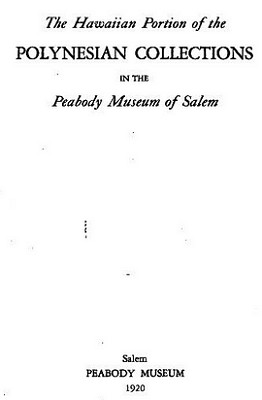
peabody museum : hawaiian collection, 1920
| home | catalogue | history | references | appendix |
 |
surfresearch.com.au
peabody museum : hawaiian collection, 1920 |
Open Library
http://openlibrary.org/books/OL6632500M/The_Hawaiian_portion_of_the_Polynesian_collections_in_the_Peabody_Museum_of_Salem.
INTRODUCTION
The Polynesian
collections of the Peabody Museum of Salem are of great ethnological value
representing as they do many specimens brought home in the early days of
the East India Marine Society.
It is impracticable
to exhibit these collections all at once but in order to bring them before
the public it seemed well to treat one group of islands at a time by means
of a special exhibition.
At the same time
a few other objects loaned by friends of the Museum are temporarily exhibited
adding to the popular interest in the collection.
With this end
in view it was decided to make the first of these special exhibitions one
of objects relating to the Hawaiian Islands.
Page 29
The canoes were
dug out from a single log, with a gunwhale, which partly covered each end,
sewed on the top with cocoanut fiber, and an outrigger boom supported by
two curved spars.
They were beautifully
executed notwithstanding the fact that the work was done with the simple
stone adz.
The whole operation
from selecting the tree to launching the finished canoe was under the direct
superintendence of a priest and was accompanied by sacrifices and prayers,
the work being considered a most serious matter.
The canoes varied
in size from those of eighteen feet in length, carrying one person, to
those of some fifty or more feet, canying forty or fifty people.
There were also
double canoes composed of two hulls attached together by spars on which
a raised platform was rigged.
These were very
steady and would carry a large number of people.
Triangular mat
sails were used.
Page 30
146.
Waa, or outrigger canoe, model. Length 3 ft. 6 in. (15542).
Gift of Stephen
W. Phillips.
147.
Waa, model, with paddle. Length 1 ft. 6 in. (5342).
Gift of Capt.
Joseph Hammond in 1864.
148.
Waa, model. Outrigger missing. Length 3 ft. 1 in. (11576).
Gift of Capt's
C. Crowninshield and M. Folger in 1802.
149.
Waa, model. Outrigger missing. Length 1 ft. 5 in. (15019).
Gift of Stephen
W. Phillips.
150.
Hoe, or paddle. Length 4 ft. 11 in., width of blade 10 in. (8155).
Gift of Dr. Charles
G. Weld.
Old Boston Museum
coll.
Page 35
The ancient Hawaiians
had a great variety of games and amusements, such as boxing, wrestling,
sliding down hill, surf-swimming, bowling, foot-races, dancing, etc., many
of which were associated with gambling to which they were greatly addicted.
...
Page 36
...
208.
Holua, or sled runner of wood. Length 8 ft. (14016).
Gift of Dr. Charles
G. Weld.
Sliding down
hill on a sled over a track of dried grass was a sport much enjoyed by
the nobility.
From the burial
cave of Kanupa, Kohala, Hawaii.
J. S. Emerson
coll.
 |
The Hawaiian Portion of the Polynesian Collections in the Peabody Museum of Salem Special Exhibition August - November, 1920. Peabody Museum, Salem, 1920. |

| home | catalogue | history | references | appendix |